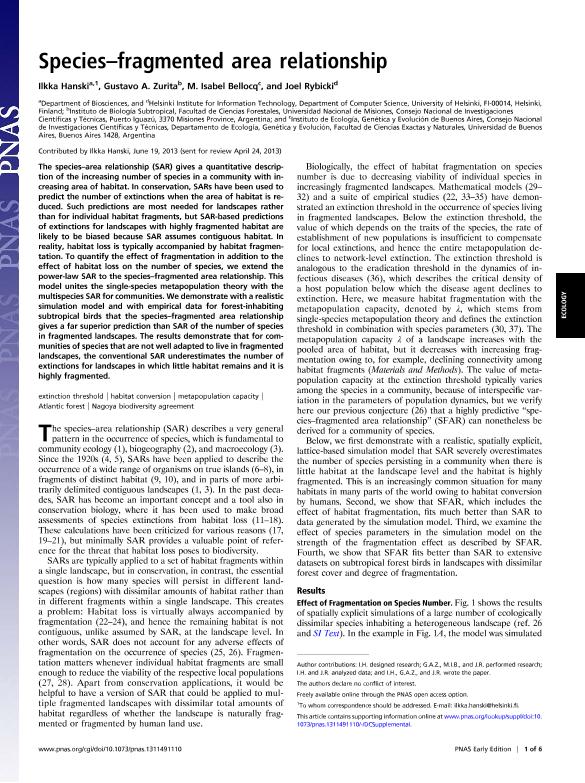Mostrar el registro sencillo del ítem
dc.contributor.author
Hansky, Ilkka
dc.contributor.author
Zurita, Gustavo Andres

dc.contributor.author
Bellocq, Maria Isabel

dc.contributor.author
Rybicki, Joel
dc.date.available
2017-01-18T18:06:39Z
dc.date.issued
2013-07
dc.identifier.citation
Hansky, Ilkka; Zurita, Gustavo Andres; Bellocq, Maria Isabel; Rybicki, Joel; The species-fragmented area relationship; National Academy Of Sciences; Proceedings Of The National Academy Of Sciences Of The United States Of America; 110; 31; 7-2013; 12715-12720
dc.identifier.issn
0027-8424
dc.identifier.uri
http://hdl.handle.net/11336/11562
dc.description.abstract
The species–area relationship (SAR) gives a quantitative description of the increasing number of species in a community with increasing area of habitat. In conservation, SARs have been used to predict the number of extinctions when the area of habitat is reduced. Such predictions are most needed for landscapes rather than for individual habitat fragments, but SAR-based predictions of extinctions for landscapes with highly fragmented habitat are likely to be biased because SAR assumes contiguous habitat. In reality, habitat loss is typically accompanied by habitat fragmentation. To quantify the effect of fragmentation in addition to the effect of habitat loss on the number of species, we extend the power-law SAR to the species–fragmented area relationship. This model unites the single-species metapopulation theory with the multispecies SAR for communities. We demonstrate with a realistic simulation model and with empirical data for forest-inhabiting subtropical birds that the species–fragmented area relationship gives a far superior prediction than SAR of the number of species in fragmented landscapes. The results demonstrate that for communities of species that are not well adapted to live in fragmented landscapes, the conventional SAR underestimates the number of extinctions for landscapes in which little habitat remains and it is highly fragmented.
dc.format
application/pdf
dc.language.iso
eng
dc.publisher
National Academy Of Sciences

dc.rights
info:eu-repo/semantics/openAccess
dc.rights.uri
https://creativecommons.org/licenses/by-nc-sa/2.5/ar/
dc.subject
Extinction Threshold
dc.subject
Habitat Conversion
dc.subject
Metapopulation Capacity
dc.subject
Atlantic Forest
dc.subject.classification
Ecología

dc.subject.classification
Ciencias Biológicas

dc.subject.classification
CIENCIAS NATURALES Y EXACTAS

dc.title
The species-fragmented area relationship
dc.type
info:eu-repo/semantics/article
dc.type
info:ar-repo/semantics/artículo
dc.type
info:eu-repo/semantics/publishedVersion
dc.date.updated
2016-12-26T18:45:25Z
dc.journal.volume
110
dc.journal.number
31
dc.journal.pagination
12715-12720
dc.journal.pais
Estados Unidos

dc.journal.ciudad
Washington DC
dc.description.fil
Fil: Hansky, Ilkka. University of Helsinki; Finlandia
dc.description.fil
Fil: Zurita, Gustavo Andres. Consejo Nacional de Investigaciones Científicas y Técnicas. Centro Científico Tecnológico Nordeste. Instituto de Biología Subtropical; Argentina. Universidad Nacional de Misiones; Argentina
dc.description.fil
Fil: Bellocq, Maria Isabel. Universidad de Buenos Aires. Facultad de Ciencias Exactas y Naturales. Departamento de Ecología, Genética y Evolución; Argentina. Consejo Nacional de Investigaciones Científicas y Técnicas. Oficina de Coordinación Administrativa Ciudad Universitaria. Instituto de Ecología, Genética y Evolución de Buenos Aires; Argentina
dc.description.fil
Fil: Rybicki, Joel. University of Helsinki; Finlandia
dc.journal.title
Proceedings Of The National Academy Of Sciences Of The United States Of America

dc.relation.alternativeid
info:eu-repo/semantics/altIdentifier/url/http://www.pnas.org/content/110/31/12715.abstract
dc.relation.alternativeid
info:eu-repo/semantics/altIdentifier/url/http://dx.doi.org/10.1073/pnas.1311491110
Archivos asociados
